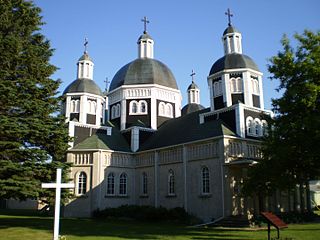
Dauphin is a city in Manitoba, Canada, with a population of 8,457 as of the 2016 Canadian Census, with an additional 2,388 living in the surrounding Rural Municipality of Dauphin (RM), for a total of 10,845 in the RM and city combined. The city takes its name from Lake Dauphin and Fort Dauphin, which were named by explorer Pierre Gaultier de La Vérendrye in honour of the Dauphin of France, the heir to the French throne. Dauphin is Manitoba's ninth largest community and serves as a hub to the province's Parkland Region. The current mayor of Dauphin is Christian Laughland. Conservative Dan Mazier has been the member of Parliament for the Dauphin—Swan River—Marquette riding since November 2010. Progressive Conservative Brad Michaleski is the current member of the Legislative Assembly.
Roblin is an unincorporated urban community in the Municipality of Roblin, Manitoba, Canada. It is located approximately 400 km (250 mi) northwest of Winnipeg.
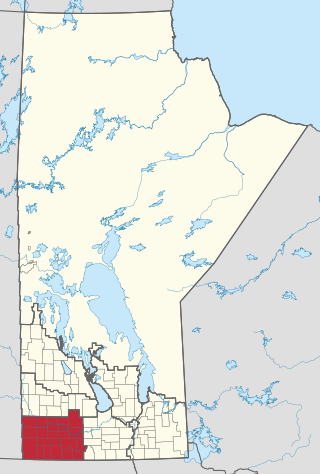
The Westman Region is an informal geographic region of the Canadian province of Manitoba located in the southwestern corner of the province.

Winkler is a city in Manitoba, Canada with a population of 13,745, making it the 4th largest city in Manitoba, as of the 2021 Canadian census. It is located in southern Manitoba, surrounded by the Rural Municipality of Stanley, about one hundred kilometres southwest of Winnipeg and thirteen kilometres east of its "twin city" Morden. As the largest city in the Pembina Valley, it serves as a regional hub for commerce, agriculture and industry. Winkler is the third-fastest growing city in the province after Morden and Steinbach.

Morden is a city located in the Pembina Valley region of southern Manitoba, Canada near the United States border. It is about 11 km (6.8 mi) west of the neighbouring city of Winkler; together Morden and Winkler are often referred to as Manitoba's Twin Cities. Morden, which is surrounded by the Rural Municipality of Stanley, is the eighth largest and fastest-growing city in Manitoba. According to Statistics Canada, the city had a population of 9,929 in 2021, an increase of 14.5% from 2016, making it Manitoba's fastest growing city.
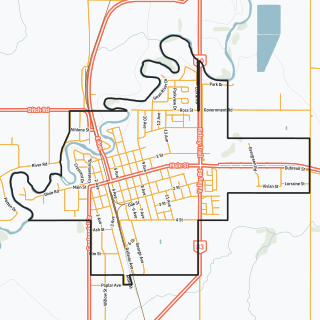
Swan River is a town in Manitoba, Canada. It is surrounded by the Municipality of Swan Valley West in the Swan River Valley region. According to the 2021 Canadian Census, Swan River had a population of 4,049, making it Manitoba's 18th largest in population.
Icelandic Canadians are Canadian citizens of Icelandic ancestry or Iceland-born people who reside in Canada.
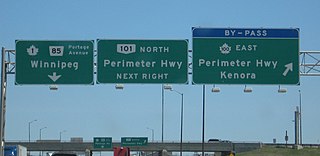
Provincial Trunk Highways (PTH) 100 and 101, collectively known as the Perimeter Highway, form a beltway around the Canadian city of Winnipeg, Manitoba. The Perimeter Highway is approximately 90 km (56 mi) in length and serves as a ring road around Winnipeg for through traffic. It is often considered by local residents to be the city's unofficial boundary, although approximately three-quarters of the Perimeter Highway actually lies in the other municipalities within the Winnipeg Metropolitan Region.
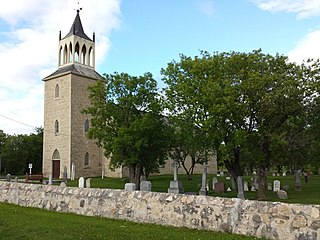
St. Andrews is a rural municipality in Manitoba, Canada. It lies west of the Red River; its southern border is approximately 8 kilometres (5.0 mi) north of Winnipeg.

Provincial Trunk Highway 2 is a 315-kilometre (196-mile) highway in the Canadian province of Manitoba. It runs from Highway 13 at the Manitoba-Saskatchewan border to Winnipeg's Perimeter Highway near Oak Bluff.
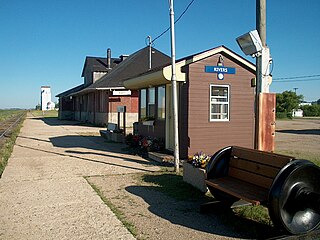
Rivers is an unincorporated urban community in the Riverdale Municipality within the Canadian province of Manitoba. It is located 40 kilometres (25 mi) northwest of Brandon, 473 metres (1,552 ft) above sea level. It is within the Westman Region. Agriculture, health and related businesses provide income for the community and area. Rivers has a population of 1,257 people in the 2016 census.
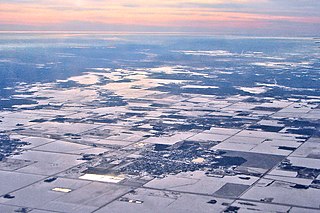
Beausejour is a town in the Canadian province of Manitoba. It is 46 kilometres northeast of Winnipeg, just west of the Canadian Shield and Whiteshell Provincial Park. The French name Beauséjour [beau + séjour] means "beautiful stay". The town is surrounded by the Rural Municipality of Brokenhead. Originally known as Stony Prairie, Beausejour was named in 1877 by Mrs H.W.D. Armstrong, wife of a government railway surveyor, when a telegraph office was installed there to serve settlers along the nearby Brokenhead River.

Stonewall is a town in the Canadian province of Manitoba with a population of 5,046 as of the 2021 census. The town is situated approximately 25 kilometres (16 mi) north of Winnipeg on PTH 67. It is known for its limestone quarries. The local festival is the Quarry Days which is usually held over three days in August on Main Street. The town is surrounded by the R.M. of Rockwood.

For the community of the same name, see: Macdonald, Manitoba
Île-des-Chênes is an unincorporated community in Manitoba, Canada, within the Rural Municipality of Ritchot. The community is located 13 kilometres south-east of the provincial capital Winnipeg, just east of Highway 59. Île-des-Chênes is a French name, translating to Island of the Oaks, coming from a nearby stand of oaks on higher ground, where early settlers sought refuge from the annual spring floodwaters.

St. Adolphe, or Saint Adolphe, originally called Pointe-Coupée, is a community in the Rural Municipality of Ritchot, Manitoba, Canada. It is located along the east bank of the Red River, approximately 12 kilometres south of Winnipeg.

Ste. Anne, or Sainte-Anne-des-Chênes, is a town in Manitoba, Canada, located about 42 km southeast of Winnipeg. The population was 2,114 in 2016, 1,524 in 2011, and 1,513 in 2011. It is known for being located on the Seine River and at the heart of the Old Dawson Trail. The town is surrounded by the Rural Municipality of Ste. Anne.
Sanford is an unincorporated community in the Rural Municipality of Macdonald in Manitoba.
La Salle, Manitoba is a town located in the Rural Municipality of Macdonald along the banks of the La Salle River, about 30 kilometres (19 mi) south of downtown Winnipeg.
Provincial Road 330 (PR 330) is a provincial road in the south-central part of the Canadian province of Manitoba. It is a heavily used route linking the city of Winnipeg with the bedroom community of La Salle and an alternate to Provincial Trunk Highway 75 (PTH 75), the main highway between Winnipeg and the town of Morris.















